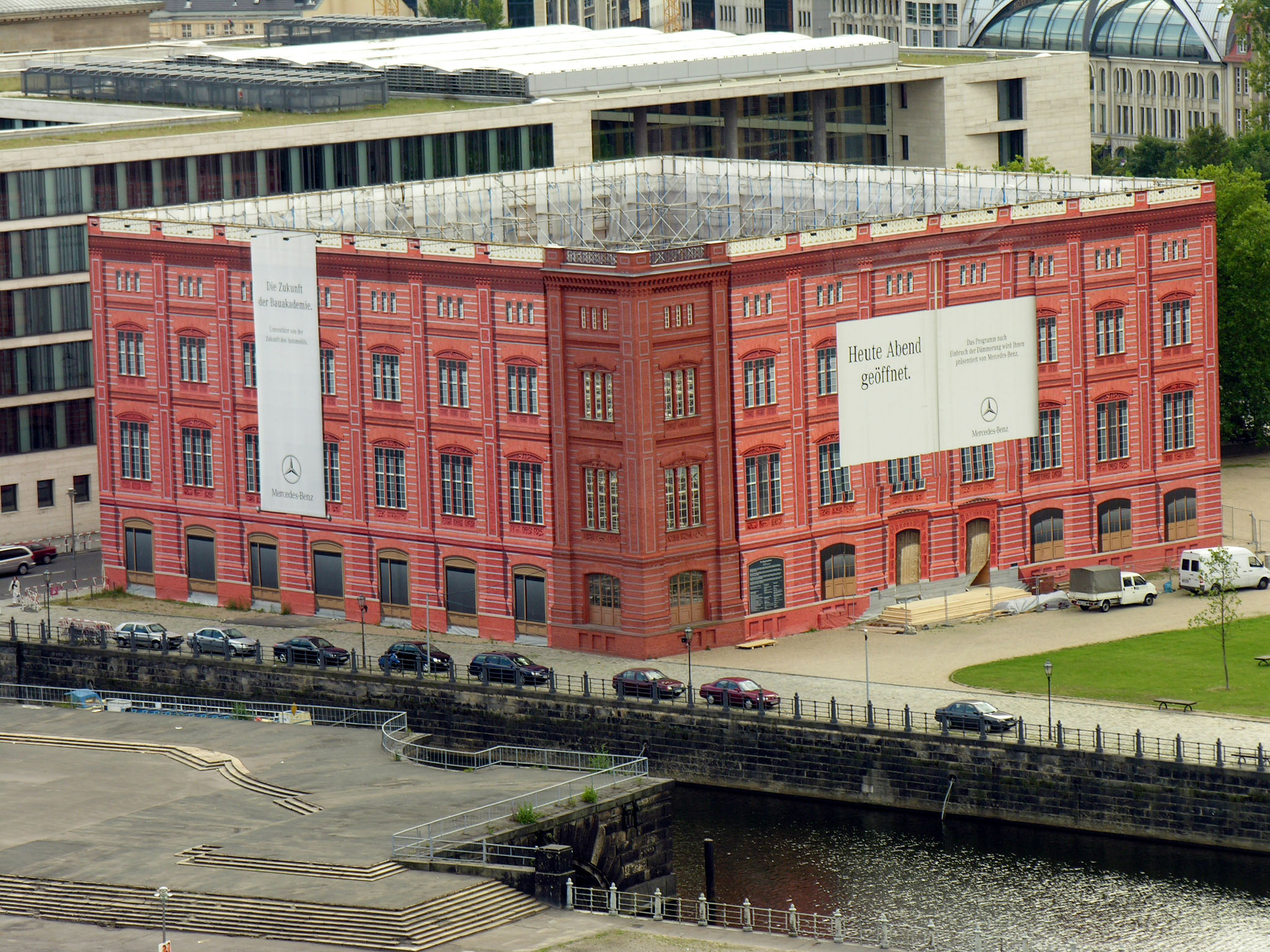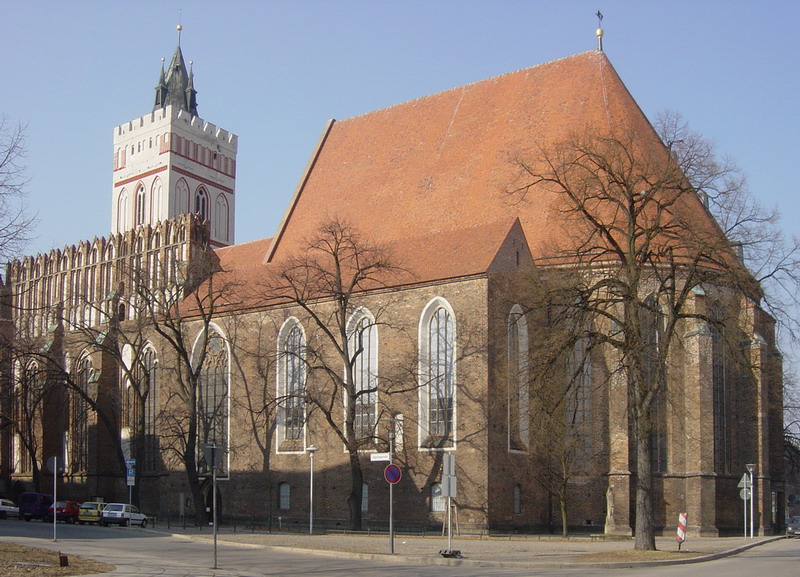|
Emil Flaminius
Emil Karl Alexander Flaminius (1807, Küstrin - 7 October 1893, Berlin) was a Prussian architect and master builder. History Flaminius grew up in Küstrin during the Napoleonic Wars and the period of reconstruction after the departure of the Napoleonic occupying forces in 1814. For twenty years he worked on the Oder and Warthe dykes in his home town. In 1828 he moved to Berlin to study architecture at the Bauakademie, where he came into contact with Karl Friedrich Schinkel. He frequently collaborated with Schinkel in the following years and even began to implement some of Schinkel's projects whilst still studying. For example, aged only 21, he worked with Schinkel on repairing the Frankfurter Marienkirche after the collapse of its south tower - the project did not replace the south tower, but did produce one of the largest works of Brick Gothic Brick Gothic (german: Backsteingotik, pl, Gotyk ceglany, nl, Baksteengotiek) is a specific style of Gothic architecture common ... [...More Info...] [...Related Items...] OR: [Wikipedia] [Google] [Baidu] |
Bauakademie
The Bauakademie (''Building Academy'') in Berlin, Germany, was a higher education school for the art of building to train master builders. It originated from the construction department of the Academy of Fine Arts and Mechanical Sciences (from 1704), which emphasized the aesthetic elements of art of building while ignoring the technical. Thus, the governmental Upper Building Department ("UBD") decided to establish an entirely new building educational institution named "Bauakademie". It was founded on 18 March 1799 by King Frederick William III and, in 1801, incorporated into the UBD, as its section. History The building of the ''Building Academy'' (''Bauakademie''), built between 1832 and 1836 (later known as ''Schinkel's Bauakademie''), is considered one of the forerunners of modern architecture due to its hithertofore uncommon use of red brick and the relatively streamlined facade of the building. Designed by Karl Friedrich Schinkel, it was built near the Berlin City Palac ... [...More Info...] [...Related Items...] OR: [Wikipedia] [Google] [Baidu] |
19th-century German Architects
The 19th (nineteenth) century began on 1 January 1801 ( MDCCCI), and ended on 31 December 1900 ( MCM). The 19th century was the ninth century of the 2nd millennium. The 19th century was characterized by vast social upheaval. Slavery was abolished in much of Europe and the Americas. The First Industrial Revolution, though it began in the late 18th century, expanding beyond its British homeland for the first time during this century, particularly remaking the economies and societies of the Low Countries, the Rhineland, Northern Italy, and the Northeastern United States. A few decades later, the Second Industrial Revolution led to ever more massive urbanization and much higher levels of productivity, profit, and prosperity, a pattern that continued into the 20th century. The Islamic gunpowder empires fell into decline and European imperialism brought much of South Asia, Southeast Asia, and almost all of Africa under colonial rule. It was also marked by the collapse of the large S ... [...More Info...] [...Related Items...] OR: [Wikipedia] [Google] [Baidu] |
1893 Deaths
Events January–March * January 2 – Webb C. Ball introduces railroad chronometers, which become the general railroad timepiece standards in North America. * Mark Twain started writing Puddn'head Wilson. * January 6 – The Washington National Cathedral is chartered by Congress; the charter is signed by President Benjamin Harrison. * January 13 ** The Independent Labour Party of the United Kingdom has its first meeting. ** U.S. Marines from the ''USS Boston'' land in Honolulu, Hawaii, to prevent the queen from abrogating the Bayonet Constitution. * January 15 – The ''Telefon Hírmondó'' service starts with around 60 subscribers, in Budapest. * January 17 – Overthrow of the Kingdom of Hawaii: Lorrin A. Thurston and the Citizen's Committee of Public Safety in Hawaii, with the intervention of the United States Marine Corps, overthrow the government of Queen Liliuokalani. * January 21 ** The Cherry Sisters first perform in Marion, Iowa. ** The Ta ... [...More Info...] [...Related Items...] OR: [Wikipedia] [Google] [Baidu] |
1807 Births
Eighteen or 18 may refer to: * 18 (number), the natural number following 17 and preceding 19 * one of the years 18 BC, AD 18, 1918, 2018 Film, television and entertainment * ''18'' (film), a 1993 Taiwanese experimental film based on the short story ''God's Dice'' * ''Eighteen'' (film), a 2005 Canadian dramatic feature film * 18 (British Board of Film Classification), a film rating in the United Kingdom, also used in Ireland by the Irish Film Classification Office * 18 (''Dragon Ball''), a character in the ''Dragon Ball'' franchise * "Eighteen", a 2006 episode of the animated television series ''12 oz. Mouse'' Music Albums * ''18'' (Moby album), 2002 * ''18'' (Nana Kitade album), 2005 * '' 18...'', 2009 debut album by G.E.M. Songs * "18" (5 Seconds of Summer song), from their 2014 eponymous debut album * "18" (One Direction song), from their 2014 studio album ''Four'' * "18", by Anarbor from their 2013 studio album '' Burnout'' * "I'm Eighteen", by Alice Cooper common ... [...More Info...] [...Related Items...] OR: [Wikipedia] [Google] [Baidu] |
Brick Gothic
Brick Gothic (german: Backsteingotik, pl, Gotyk ceglany, nl, Baksteengotiek) is a specific style of Gothic architecture common in Northeast and Central Europe especially in the regions in and around the Baltic Sea, which do not have resources of standing rock, but in many places many glacial boulders. The buildings are essentially built using bricks. Buildings classified as Brick Gothic (using a strict definition of the architectural style based on the geographic location) are found in Belgium (and the very north of France), Netherlands, Germany, Poland, Lithuania, Latvia, Estonia, Kaliningrad (former East Prussia), Denmark, Sweden and Finland. As the use of baked red brick arrived in Northwestern and Central Europe in the 12th century, the oldest such buildings are classified as the Brick Romanesque. In the 16th century, Brick Gothic was superseded by Brick Renaissance architecture. Brick Gothic is characterised by the lack of figurative architectural sculpture, wides ... [...More Info...] [...Related Items...] OR: [Wikipedia] [Google] [Baidu] |
Marienkirche Frankfurt (Oder)
The Marienkirche is a Protestant church in Frankfurt (Oder) in Germany. It was formerly the city's main parish church and was built over more than 250 years, during the Middle Ages. History To 1522 It was first built in 1253, just after the foundation of the city, and was one of the earliest examples of a gallery in the architecture of the Margraviate of Brandenburg. An ambulatory hall was built to replace the original choir and a polygonal entrance hall with a sandstone entrance arch built onto the north transept, both between 1360 and 1370. The nave was expanded as a five-bayed construction in the 15th century with painted ceilings in the side bays and a 14-storey new tower façade built around 1450. An eight-pointed cupola was added to the north tower and a crenellated edge to the south tower. On the establishment of the Viadrina University a new galleried sacristy was built between 1521 and 1522 – this was the last major expansion of the building, which is now 77 met ... [...More Info...] [...Related Items...] OR: [Wikipedia] [Google] [Baidu] |
Karl Friedrich Schinkel
Karl Friedrich Schinkel (13 March 1781 – 9 October 1841) was a Prussian architect, city planner and painter who also designed furniture and stage sets. Schinkel was one of the most prominent architects of Germany and designed both neoclassical and neogothic buildings. His most famous buildings are found in and around Berlin. Biography Schinkel was born in Neuruppin, Margraviate of Brandenburg. When he was six, his father died in the disastrous Neuruppin fire of 1787. He became a student of architect Friedrich Gilly (1772–1800) (the two became close friends) and his father, David Gilly, in Berlin. At that time, the architectural taste in Prussia was shaped in neoclassical style, mainly by Carl Gotthard Langhans, the architect of the Brandenburg Gate in Berlin. After returning to Berlin from his first trip to Italy in 1805, he started to earn his living as a painter. When he saw Caspar David Friedrich's painting ''Wanderer above the Sea of Fog'' at the 1810 Berlin art ... [...More Info...] [...Related Items...] OR: [Wikipedia] [Google] [Baidu] |
Levee
A levee (), dike (American English), dyke (English in the Commonwealth of Nations, Commonwealth English), embankment, floodbank, or stop bank is a structure that is usually soil, earthen and that often runs parallel (geometry), parallel to the course of a river in its floodplain or along low-lying coastlines. The purpose of a levee is to keep the course of rivers from changing and to protect against flooding of the area adjoining the river or coast. Levees can be naturally occurring ridge structures that form next to the bank of a river, or be an artificially constructed fill dirt, fill or wall that regulates water levels. Ancient civilizations in the Indus Valley civilisation, Indus Valley, ancient Egypt, Mesopotamia and China all built levees. Today, levees can be found around the world, and failures of levees due to erosion or other causes can be major disasters. Etymology Speakers of American English (notably in the Midwestern United States, Midwest and Deep South) u ... [...More Info...] [...Related Items...] OR: [Wikipedia] [Google] [Baidu] |
Berlin
Berlin ( , ) is the capital and largest city of Germany by both area and population. Its 3.7 million inhabitants make it the European Union's most populous city, according to population within city limits. One of Germany's sixteen constituent states, Berlin is surrounded by the State of Brandenburg and contiguous with Potsdam, Brandenburg's capital. Berlin's urban area, which has a population of around 4.5 million, is the second most populous urban area in Germany after the Ruhr. The Berlin-Brandenburg capital region has around 6.2 million inhabitants and is Germany's third-largest metropolitan region after the Rhine-Ruhr and Rhine-Main regions. Berlin straddles the banks of the Spree, which flows into the Havel (a tributary of the Elbe) in the western borough of Spandau. Among the city's main topographical features are the many lakes in the western and southeastern boroughs formed by the Spree, Havel and Dahme, the largest of which is Lake Müggelsee. Due to its l ... [...More Info...] [...Related Items...] OR: [Wikipedia] [Google] [Baidu] |
Warthe
The river Warta ( , ; german: Warthe ; la, Varta) rises in central Poland and meanders greatly north-west to tributary, flow into the Oder, against the Germany, German border. About long, it is Poland's second-longest river within its borders after the Vistula, and third-longest including the Oder, that flows also across Czech Republic and Germany.Statistical Yearbook of the Republic of Poland 2017 Central Statistical Office (Poland), Statistics Poland, p. 85-86 Its drainage basin covers and it is navigable from Kostrzyn nad Odrą to Konin, approximately half of its length. [...More Info...] [...Related Items...] OR: [Wikipedia] [Google] [Baidu] |
Oder
The Oder ( , ; Czech, Lower Sorbian and ; ) is a river in Central Europe. It is Poland's second-longest river in total length and third-longest within its borders after the Vistula and Warta. The Oder rises in the Czech Republic and flows through western Poland, later forming of the border between Poland and Germany as part of the Oder–Neisse line. The river ultimately flows into the Szczecin Lagoon north of Szczecin and then into three branches (the Dziwna, Świna and Peene) that empty into the Bay of Pomerania of the Baltic Sea. Names The Oder is known by several names in different languages, but the modern ones are very similar: English and ; Czech, Polish, and , ; (); Medieval Latin: ''Od(d)era''; Renaissance Latin: ''Viadrus'' (invented in 1534). Ptolemy knew the modern Oder as the Συήβος (''Suebos''; Latin ''Suevus''), a name apparently derived from the Suebi, a Germanic people. While he also refers to an outlet in the area as the Οὐιαδούα ''Oui ... [...More Info...] [...Related Items...] OR: [Wikipedia] [Google] [Baidu] |







